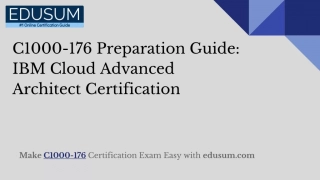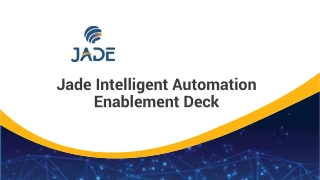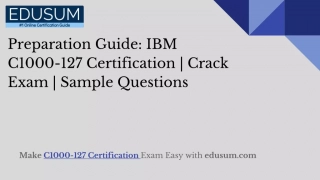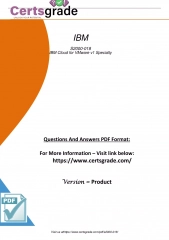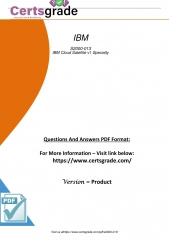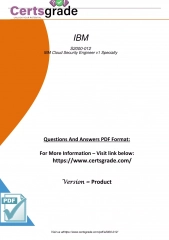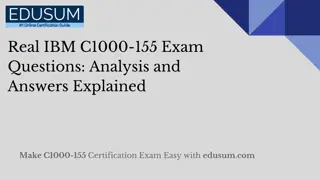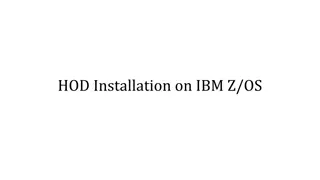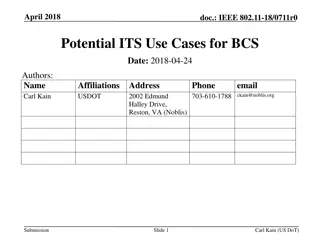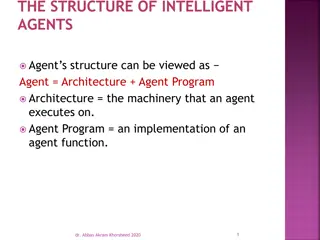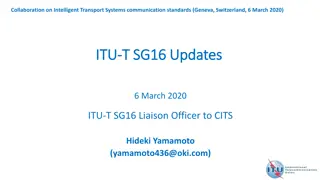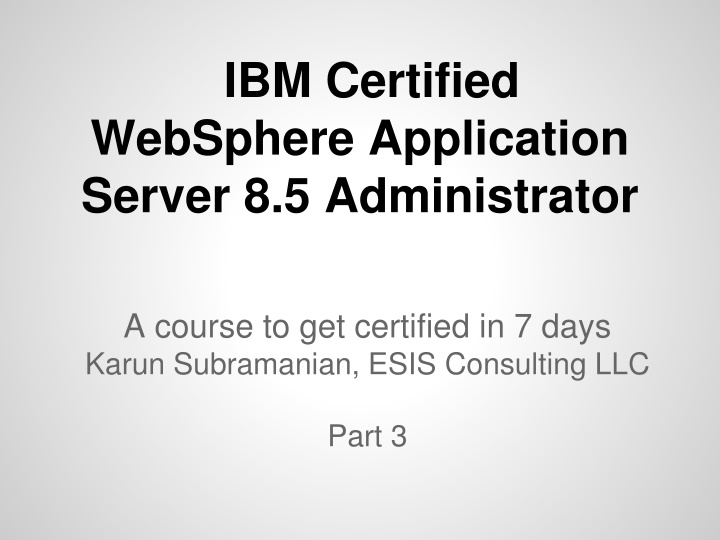
Intelligent Management and Resiliency in IBM Certified WebSphere Application Server 8.5
Explore the intelligent management features of IBM Certified WebSphere Application Server 8.5, including on-demand routing, health management, dynamic clusters, application edition management, and more. Learn how these components work together to provide a resilient environment for your applications with minimal administrative overhead.
Download Presentation

Please find below an Image/Link to download the presentation.
The content on the website is provided AS IS for your information and personal use only. It may not be sold, licensed, or shared on other websites without obtaining consent from the author. If you encounter any issues during the download, it is possible that the publisher has removed the file from their server.
You are allowed to download the files provided on this website for personal or commercial use, subject to the condition that they are used lawfully. All files are the property of their respective owners.
The content on the website is provided AS IS for your information and personal use only. It may not be sold, licensed, or shared on other websites without obtaining consent from the author.
E N D
Presentation Transcript
IBM Certified WebSphere Application Server 8.5 Administrator A course to get certified in 7 days Karun Subramanian, ESIS Consulting LLC Part 3
Section 7 Intelligent Management and Resiliency
Introduction Introduced with WAS 8.5 Provides services to create virtualized Application Serving environment with minimum administrative overhead Detect issues and dynamically change runtimes You configure policies that govern the performance and health of the environment Application editions enable rolling out applications without impacting users
Components of Intelligent Management On Demand Routers: Requests are prioritized and routed based on rules. Can be configured as Servers or run in Web Server using Intelligent Management enabled plug in Health Management: Monitors Servers and takes actions based on health policies defined Dynamic Clusters/Performance Management: Cluster members automatically created/removed, started/stopped based on policies defined Application Edition Management: No downtime during Application update Overload protection: Automatically take action based on CPU and/or Memory exhaustion
Components of Intelligent Management Cont... Autonomic Managers Make decisions for the environment including Application management, traffic shaping and health placement APC - Application Placement Controller: manages Dynamic Clusters Dynamic workload manager (DWLM) Autonomic request flow manager (ARFM) Health Controller Service Policies: Settings that you define to govern the request priority
Components of Intelligent Management Cont... Three types of Service Policies Discretionary: Default service goal. Processed when no higher request is waiting Avg response time: Ex: 3500 milliseconds Percentile Response time: Ex: 90% of all requests must be processed within 2 seconds Seven levels of importance can be set on service policy (Highest,Higher,High,Medium,Low,Lower,Lowest) Work Class is a grouping of work to process (HTTP,SOAP,IIOP,JMS). Maps the request to a transaction Class
Components of Intelligent Management Cont... Work class request classification rules allow requests to be classified. Uses SQL where class style rules using the information from the request (ip,user id,header etc) Transaction Class provides the link between application and service policy A service policy can have multiple transaction classes mapped to it. But a transaction class must map to only one service policy
Components of Intelligent Management Cont... Service Policy:
On Demand Router Explained Java based proxy server. Sits in front of Application Servers Routes requests to Application servers based on operational policy
Health Management Policy driven management - monitors the system and takes actions Health policies define what to monitor for and what to do when certain conditions are met Health Controller (Autonomic manager) processes the Health Policies. Actions can be done automatically or with manual intervention There is one Health Controller per cell
Health Management Cont... Health Conditions: Age Based Excessive request timeout excessive response time Excessive memory usage Excessive Garbage Collection Memory Leak Storm Drain Work Load
Health Management Cont... Health Actions Restart Server Take Thread dump (java core) Take Heap dump Put Server in maintenance mode Take out Server from maintenance mode Notify Administrator (SMTP) Send SNMP trap Custom action
Application Editions Edition Control Center manages Application editions Enables updating the application without interrupting the users Routing policy and on demand router are required to use two editions simultaneously When you need to validate an edition, you can have WAS create a dynamic cluster automatically and deploy the edition for you You must activate an edition before it can service requests
Application Editions Cont... Rolling out replaces the current application edition with new edition without interruption Requests are quiesced and rerouted to other members (or temporarily queued) while the new edition is being activated You can roll out atomically (can queue requests at ODR to ensure two editions do not serve at the same time). Deploys on half of cluster at a time) grouped (the group size defined by you). Does not queue requests
Application Editions Cont... You can choose to restart either just the application(soft) or the entire application server (hard) You can specify a drainage interval for quiescing the http requests Concurrent activation of the Application editions possible when a routing policy is defined at the ODR (ODR needs to know which group of users to route to a particular edition) With validation mode, the deployment target is cloned and the new edition is deployed for validation. After validation rollout to original
Autonomic Managers explained ARFM: Autonomic request flow managers: Controller: Governs the request flow. Runs in any node agent, ODR or dmgr gateway: per used combination of protocol family, proxy processes and deployment target. For HTTP and SIP, runs on ODR. For JMS and IIOP, runs on WAS Work flow estimator: per target cell. Runs in any node agent, ODR or dmgr Dynamic Workload Controller Dynamically adjusts server weights minimize response time. One per cluster
Autonomic Managers explained Application placement controller One per cell hosted in DMGR or node agent Manages application s location within a node group Starts and stops WAS instances to manage HTTP,SIP,JMS and IIOP traffic On Demand Configuration Manager Maintains cell topology information to keep other autonomic managers informed Enables ODR to dynamically configure routing rules based on configuration changes such as Applications installed/removed,WASs started/stopped
More on Service Policy Enables classifying, prioritizing and intelligently routing workload Sets performance goals and business importances of applications Two components of a Service Policy Importance: identifies most important work during resource contention Goal:Determines how work is evaluated to ensure service policy level Discretionary, Average Response Time, Response time percentile
More on Service Policy Cont... Service Policies are related to workload using transaction classes Work classes map workload to transaction classes Each work class is associated to: One JEE Application One of the following type of requests URL prefix for HTTP Method name for IIOP Bus + Destination for JMS Each work request belongs to exactly one transaction class. Each transaction class belongs to exactly one Service Policy
Creating a Service Policy WAS Admin Console -> Operational Policies -> Service Policy -> New Provide a name and Goal Type (Discretionary, Avg response time or Percentile response time) Associate an importance (lowest to highest) Select Monitor for persistent policy violations to setup runtime task when policy violation occurs Associate a transaction class or create a new one
Section 8 Performance Monitoring and Tuning
Performance Monitoring overview PMI (Performance Monitoring Infrastructure) JSR-77 based JEE Management Reference implementation (JMX) Java, WEB or JMX client can retrieve the performance data collected by PMI. TPV (Tivoli Performance Viewer) Viewed in Admin Console Request Metrics Tool that uses timing agents to track the individual request process time Break down of a transaction showing time spent at various subsystems
PMI PMI can be enabled or disabled using the WAS Admin Console (enabled by default) Enabling/Disabling requires Server restart Various statistics set can be configured Basic,Extended,All,Custom,None Performance overhead of PMI can be from 2 to 6 %
Request Metrics Can be enabled/disabled using WAS Admin Console. This is a cell wide change Various trace levels None, Hops, Performance Debug, Debug Finer the trace level, granular the breakdown of the response time within a transaction HTTP Plugin must be regenerated when enabling Request Metrics Additional filters can be configured to target the metrics collection to a particular subsystem Output of Request Metrics can be logged to SystemOut or sent to an ARM Agent
Viewing Performance Data Tivoli Performance Viewer is integrated with Admin Console You can view data from only one Server at a time Setting to modify refresh rate and buffer size Data can be viewed as raw,rate of change or change in value TPV data is processed by dmgr TPV data can be logged for future use
Viewing Performance Data Cont... Three ways in TPV Summary Reports General view in tabular format (Servlets, EJBs, connection pools etc) Performance Modules Tabular or graph view of real time performance data Advisors Provide tuning advice for well known hotspots (thread pool usage, jvm settings etc) based on the PMI data collected
Performance Advisors Two Advisors available Performance Advisor in TPV Performance and Diagnostic advisor Performance and Diagnostic advisor runs in the JVM of the WAS and hence not exhaustive. Logs advice in SystemOut. Performance Advisor in TPV runs in nodeagent (in ND) and viewed via TPV in Admin console. Exhaustive
Settings that affect performance Thread Pools: Limits the number of threads that the pool can spawn. Excessive threads generally lead to heavier CPU usage (due to context switching) JDBC Connection Pools: Number of connections to the backend Database. Too many connections in use may indicate Connection Pool leak JVM: GC policy must be chosen based on requirement. Frequent GC slows down the application
WebSphere Dynamic Cache Caches output of Servlets,JSPs,Web Services and commands Enabled by default Cache Monitor Web Application lets you monitor the cache performance (comes with the product) Accessed at Server -> Container Service - >Dynamic cache Allows disk offload and cache replication WebSphere eXtreme scale is the strategic direction of IBM for dynamic caching

